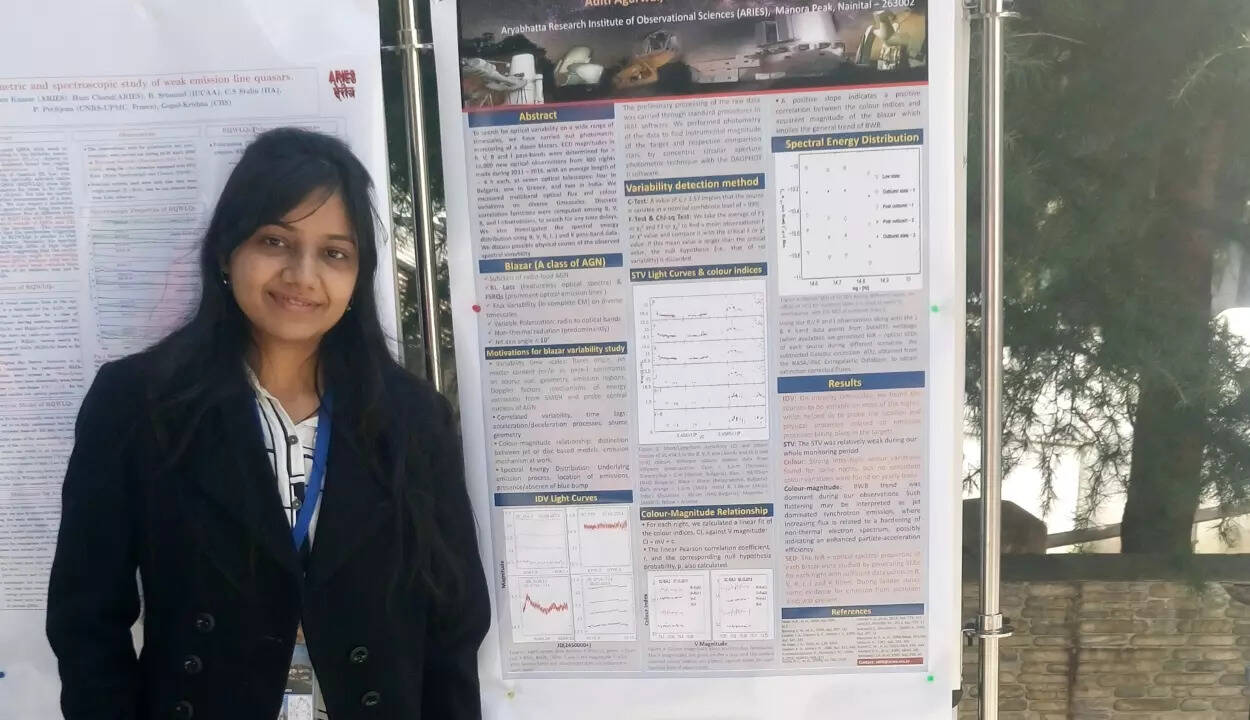[ad_1]
BENGALURU: A postdoctoral fellow from Raman Research Institute (RRI) in Bengaluru has used five different machine learning (ML) algorithms to create a new catalogue of classified blazar (extremely bright galaxies) candidates of unknown type from a specific space observatory — The Fermi Gamma-ray space telescope.
The Fermi Gamma-ray space telescope is a space observatory launched on June 11, 2008, to perform Gamma-ray astronomy observations. Over the past decade, four Fermi source catalogues (FGL) have been published at regular intervals.
These catalogues have revealed multiple high-energy sources such as active galactic nuclei or AGNs (compact region at the centre of a galaxy that has a much-higher-than-normal luminosity), pulsars (rotating neutron stars), Gamma-ray bursts, supernovae and starburst galaxies.
Recently, the third release of the fourth Fermi catalogue (DR3) of active galactic nuclei (AGNs) has been published which contains 3,407 AGNs, out of which 755 are flat spectrum radio quasars or FSRQs (a class of AGNs), 1,379 are BL Lacertae or BL Lac objects (a class of AGNs), 1,208 are blazars of unknown type, while 65 are non-AGNs.
“Accurate categorisation of many unassociated blazars still remains a challenge due to the lack of sufficient optical spectral information. Also, obtaining their multi-wavelength observations is time-consuming and thus makes it inefficient. For these reasons, ML plays a powerful role in the identification and classification of uncertain-type objects,” Aditi Agarwal, the postdoc fellow, told TOI.
In her paper published in the Astrophysical Journal, she’s shown how to perform a high-precision, optimised classification of Blazar Candidate of Uncertain type (BCU) into BL Lac objects and FSRQs by applying five different machine learning (ML) algorithms, namely, random forest, logistic regression, XGBoost, CatBoost and neural network with seven different features.
“We used a novel approach of combining predictions from multiple ML models and taking a unanimous vote to further increase the accuracy of the classification. Combining the prediction results from all five ML algorithms, we present a new catalogue of 1,115 BCUs classified as 610 BL Lac objects and 333 FSRQ candidates with the best model classification performance observed so far,” she added.
This new catalogue, she said, further increased the sample of BL Lac objects and FSRQs and is thus a step closer to the goal of identifying the complete γ-ray sky and having a more complete sample of blazars with many new targets that could be used for forthcoming multi-wavelength surveys.
“Moreover, this catalogue will also benefit the community in planning subsequent follow-up spectroscopic observations for not only optical telescopes but also present-day/future multi-frequency observatories such as Cherenkov Telescope Array, XMM-Newton, Swift, Atacama Large Millimetre/submillimetre Array, IceCube, and Imaging X-Ray Polarimetry Explorer,” she said.
The Fermi Gamma-ray space telescope is a space observatory launched on June 11, 2008, to perform Gamma-ray astronomy observations. Over the past decade, four Fermi source catalogues (FGL) have been published at regular intervals.
These catalogues have revealed multiple high-energy sources such as active galactic nuclei or AGNs (compact region at the centre of a galaxy that has a much-higher-than-normal luminosity), pulsars (rotating neutron stars), Gamma-ray bursts, supernovae and starburst galaxies.
Recently, the third release of the fourth Fermi catalogue (DR3) of active galactic nuclei (AGNs) has been published which contains 3,407 AGNs, out of which 755 are flat spectrum radio quasars or FSRQs (a class of AGNs), 1,379 are BL Lacertae or BL Lac objects (a class of AGNs), 1,208 are blazars of unknown type, while 65 are non-AGNs.
“Accurate categorisation of many unassociated blazars still remains a challenge due to the lack of sufficient optical spectral information. Also, obtaining their multi-wavelength observations is time-consuming and thus makes it inefficient. For these reasons, ML plays a powerful role in the identification and classification of uncertain-type objects,” Aditi Agarwal, the postdoc fellow, told TOI.
In her paper published in the Astrophysical Journal, she’s shown how to perform a high-precision, optimised classification of Blazar Candidate of Uncertain type (BCU) into BL Lac objects and FSRQs by applying five different machine learning (ML) algorithms, namely, random forest, logistic regression, XGBoost, CatBoost and neural network with seven different features.
“We used a novel approach of combining predictions from multiple ML models and taking a unanimous vote to further increase the accuracy of the classification. Combining the prediction results from all five ML algorithms, we present a new catalogue of 1,115 BCUs classified as 610 BL Lac objects and 333 FSRQ candidates with the best model classification performance observed so far,” she added.
This new catalogue, she said, further increased the sample of BL Lac objects and FSRQs and is thus a step closer to the goal of identifying the complete γ-ray sky and having a more complete sample of blazars with many new targets that could be used for forthcoming multi-wavelength surveys.
“Moreover, this catalogue will also benefit the community in planning subsequent follow-up spectroscopic observations for not only optical telescopes but also present-day/future multi-frequency observatories such as Cherenkov Telescope Array, XMM-Newton, Swift, Atacama Large Millimetre/submillimetre Array, IceCube, and Imaging X-Ray Polarimetry Explorer,” she said.
[ad_2]
Source link

